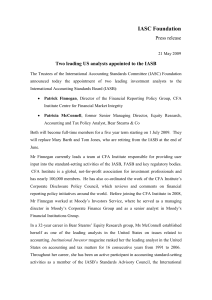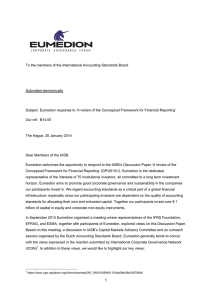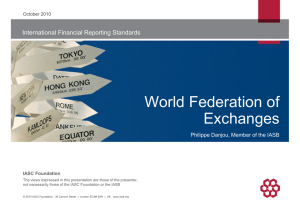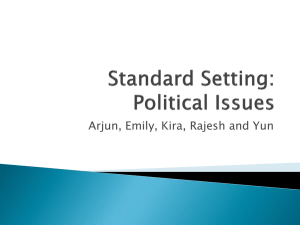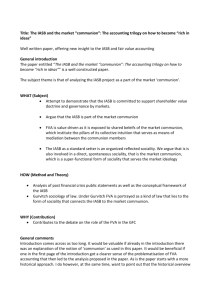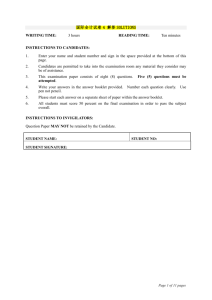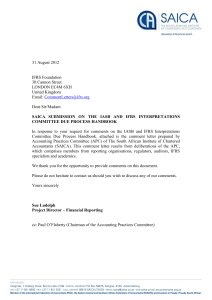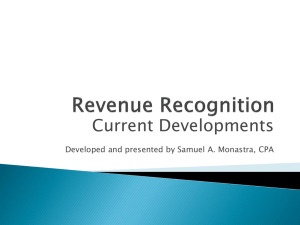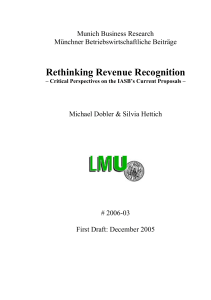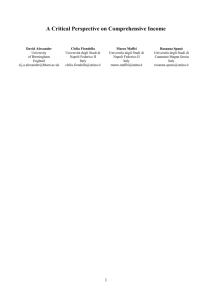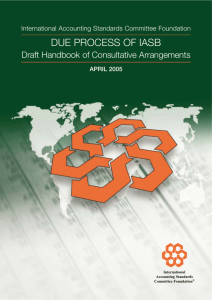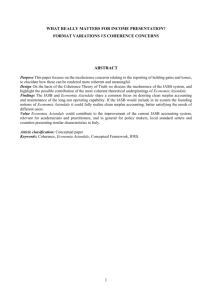Standard-Setting: Political Issues 306
advertisement
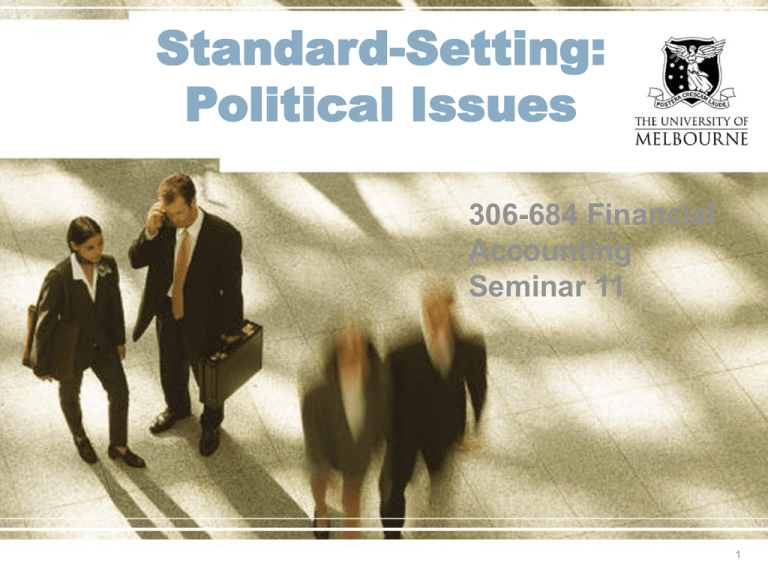
Standard-Setting: Political Issues 306-684 Financial Accounting Seminar 11 1 Learning Objectives 1 To understand relevant theories put forward to explain regulation 2 To review the history of accountingpolitics relationship 3 To discuss/debate what constitutes a “good” accounting standard 4 To assess the impact of globalisation on the standard setting 2 Recall: • Arguments against the necessity of regulation: – Contractual incentives for disclosure – Market-based incentives for disclosure • Arguments for the necessity of regulation: – Private incentives are insufficient, due to • Market failures • Information asymmetry 3 Recall: • We don’t know which set of arguments is more “robust/likely” – can’t be tested as we live in a regulated world • So, we don’t know whether increased market failures that might follow from deregulation would be more or less costly to society than the costs of regulation! • 2008! – evidence of failure? 4 Recall: • However, information asymmetry ( hence adverse selection and moral hazard problems) is pervasive and is persistent • A demand for information from firms also creates a demand for regulation, as firms supply less information than investors demand • Thus, regulation increases the amount of information disclosed, even if we don’t know the exact costs v. benefits of that increase 5 Theories of Regulation: • What theories do we have to explain the government intervention in the market for accounting information? 6 Public Interest Theory • Regulation is deemed necessary to protect the public interest, and ensure the adequate provision of accounting information. It is needed to counteract market failure, due to: – Information asymmetry – Lack of unanimity – “public good” nature of accounting information 7 Public Interest Theory • These factors will all lead to the undersupply and over-pricing of accounting information • The government is assumed to be a neutral party who intervenes to protect the public interest – “first best solution” to maximise social welfare – Trade off costs of regulation with social benefit of efficient markets and allocation of scarce resources 8 Public Interest Theory • Problems – What is the “right” amount of information and regulation? – Impossible to please every constituency! – What are the motivations of the regulators? • Are they really acting in the public interest? 9 Interest Group Theory • Governments are not neutral: politicians and regulators are also rational and selfinterested • There are conflicts between interest groups and constituencies – e.g. between firms and environmentalists • A “second best” solution – regulator maximises own interest while balancing those of constituents (such as managers and investors), including the political authority 10 Interest Group Theory • The larger, more powerful interest groups (able to organize and bear the costs of lobbying) are able to trade votes and other benefits for their desired regulation • Consistent with the “political costs” theory of PAT – Firms want to minimise their political costs and maximise their political benefits 11 Theories of Regulation • Which theory do think is the better explanation of reality? Public interest or Interest group theory? • Interest group theory – more cynical, but more realistic? 12 The Accounting-Politics Relationship • Accounting information is implicated in economic crises (e.g. Enron, Lehman Bros.) • Crises create potential for political rewards (govt seen as “White Knight”) – Politicians and regulators increase regulation to “solve” problem – Accounting profession “self-regulates” to avoid increase in government regulation • Consequence – continual increase in accounting regulation! 13 Historical Examples … • 1929 Stockmarket Crash in US – Preceded by high reported profits and high firm values – Assertion was that these were artificially inflated and over-valued – Consequence: formation of SEC in 1934, mandatory requirement that firms provide audited financial statements, prohibition of asset revaluations 14 Historical Examples … • Australia in the 1960s – Failure of large land development companies – Threat of government intervention – Professional bodies produce first accounting standards • 1984 – standard setting “taken over” by govt – compliance now mandatory • October 1987 Crash – followed by increased regulation 15 Examples … • More recently (2001) – US – failure of Enron, WorldCom, Arthur Andersen,etc • Consequence: Sarbanes-Oxley [SOX] – Australia – failure of HIH • Consequence: Ramsay report on auditor independence, Royal Commission, reforms to Corporations Law 16 2008 • Failures of banks – large, small and international eg. Lehman Bros, Fortis, etc. • Sub-prime mortgage defaults created bad debts that resulted in banks unwilling and unable to lend to other banks • Consequence – unprecedented response by governments to inject capital and to take equity positions in banks 17 The Big Questions • Will regulatory changes prevent future corporate failures of this kind? i.e. will the benefits exceed the costs? • What changes to regulations will take place post-2008? 18 Criteria for Standard Setting • Investors’ demands on standard setting – They want information to predict future firm performance – They want full disclosure, transparency, fair values • Managers’ demands on standard setting – They want flexibility to control (manage) reported net income – They want income to be informative about effort 19 Criteria for Standard Setting • For a successful accounting standard: – Decision usefulness – Reduce information asymmetry – Economic consequences • benefit > social cost – Acceptable to constituencies 20 Conflicts and Compromises in Standard Setting • Difficulties faced by IASB in developing IAS 39 (AASB 139) illustrate extent of constituency conflict in standard setting – Concerns of several constituencies • • • • European Central Bank European Union carveout Danish regulators Association of Corporate Treasurers – IASB compromises • Macro hedging • Restrict fair value option 21 Conflicts and Compromises in Standard Setting • Concerns about Fair Value accounting in the banking sector – Volatility in fair value, especially to long-term lending – Reliability of fair value for bank loans proper market? Mathematical model? – Revaluation gain from the deterioration of own credit risk – Not conservative accounting practice • Result: “carved out” fair value option and strict provision for hedging in IAS 39 22 Conflicts and Compromises • Other comprehensive income – Items included • Unrealized gains and losses on available-for-sale securities • Unrealized gains and losses on cash flow hedges – Rationale • To secure management constituency’s acceptance of fair value accounting 23 Example: Other Comprehensive Income (two options for presentation) • Presented with Income Statement – – – – – Net income from operations Extraordinary items Net income Other comprehensive income Comprehensive income xxx xxx xxx xxx xxx • Or, Alternative Presentation – As part of statement of changes in shareholders’ equity • Less transparent, especially if securities markets not fully efficient • Firms’ choice of alternative has information content for investors 24 Rules v Principles • Rules-based standards – Lay down detailed rules – Possible? • Principles-based standards – General principles to be applied – Auditor professional judgment to prevent opportunistic manager behaviour – Possible? 25 International Integration of Capital Markets • Increasing adoption of IASB standards – Some examples • • • • • European Union, 2005 China, Japan (partially) Australia, 2005 Canada, from 2011 United States? – Allows foreign companies under SEC jurisdiction to report using IASB standards without reconciliation, 2007 – Norwalk Agreement to work towards standards convergence 26 International Integration of Capital Markets • Effect of customs and institutions – Code law countries • Greater influence of families and banks in corporate governance than in common law countries • Lower moral hazard problem • Shows up as less timely and less conservative reporting, even if country has adopted IASB standards – Implication that investors should be aware of local practices and customs when interpreting financial statements, even if country uses IASB standards 27 International Integration of Capital Markets • Role of auditor – Even high quality standards must be enforced – Protection of small investors • Moral hazard problem switches to one between an entrenched controlling interest and small investors – Auditor may be under great pressure from controlling interests • Some evidence that auditors succumb to this pressure – Guedhami & Pittman (2006) 28 International Integration of Capital Markets • Benefits of high quality accounting standards – Better working securities markets – Higher earnings quality – More foreign investment 29 International Integration of Capital Markets • Should standard setters compete? – e.g., if firms could choose between IASB & FASB standards • Race to the bottom? • Race to the top? (Problem 13.7) – Firms could signal commitment to high quality reporting by choosing the higher quality standards • Do benefits of competition outweigh increased costs of allowing 2 sets of standards? 30 Conclusions • Interest group theory better explains the current accounting regulation • Stricter regulation follows each major market failure • Accounting standard setting is a political process involves conflicts and compromises • International accounting standards should be carefully implemented to be effective 31


